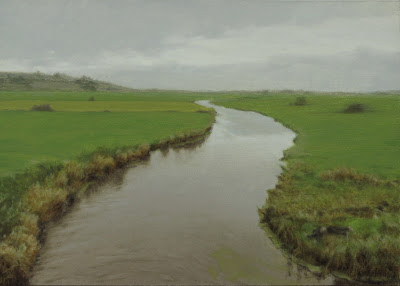oil on card 21x15cm
This is the third of the set of four postcard pieces, and has some music to go with it – Gnossienes No.1, by Eric Satie. It’s what I was listening to while painting this and it fitted perfectly. It’s played painfully slowly, but I find it compelling.
Before I go further I should perhaps temper the enthusiastic promotion of thicker Stand Oil paint mixtures in the previous post. Having completed this piece I had some unexpected trouble when I sprayed it with a temporary light retouch varnish to even up the finish a bit. Alarmingly, the glossy ‘oiliest’ bits became even glossier, and the varnish cissed and bobbled on the more matt parts, which was precisely the opposite of my intent. A second spray coat did the same, and I had to brush the still-wet varnish with a hog brush till it got tacky, while desperately hoping that the paint beneath was dry enough not to smear. Luckily, it was firm enough and I ended up with a broadly even surface. Phew. Next time I think I’ll let the paint dry a bit longer before the retouch spray. Or just not use the retouch spray.
As you can tell from the Google Streetview source, there’s been a bit of compositional editing here. The left bank sits at a different angle from the main source – it’s imported from the next image to the left and fits the corner much better. Likewise the unwanted road on the right bank has been replaced with grass areas from just past the bridge on the right.
I like this landscape very much. It’s a patch of marshy land in Normandy, and I put it in my ‘Ideas’ folder about four years ago. The light is northern and grey, but the scene is calm and serene. I was well into the second work session, though, when the painting started demanding a Bad Thing. I knew it would have to be in the near grass on the right, and I knew it was going to be a dead body. It’s a man, and he’s dressed in black, and you do have to look closely to find him as he is so tiny. The daylight around that time was particularly dark and overcast, and I had to rely on lights and a magnifying glass to see what I was doing. As ever, the whole painting changes once he’s seen, and makes it more complete and thought-provoking, and I may paint a larger version at some point.
I’ll not say anything about the final picture yet (that’ll have a blog post all to itself at some point, perhaps in December). All four postcard pieces have been completed, and were dropped off at the Open Eye Gallery for their annual ‘On a Small Scale’ show yesterday (exciting for me as it’s my first invite to participate there). They will form part of the big blocks of work at some point, but the display changes as the stock sells and gets replaced, so I can’t be certain when they will be on the walls. The show is open from Saturday 25th November till 23rd December, so if you’re in Edinburgh, go and have a look - there’s a lot of very good, very small work by a wide variety of painters on show.
Production of ‘Monfréville’, and the fourth one, began after the first two paintings of the series were well on the way. I’m not sure whether the increasingly fraught events since early October have affected it except possibly to have made me seek the calm in it. It was completed on the morning 25th October. In the afternoon Madam and I went down the road for my mother’s arrival at her nursing home in Edinburgh. She was there for ten days, and we visited every (except one) day, and then she died.
Madam and I were both there, and it was peaceful.

